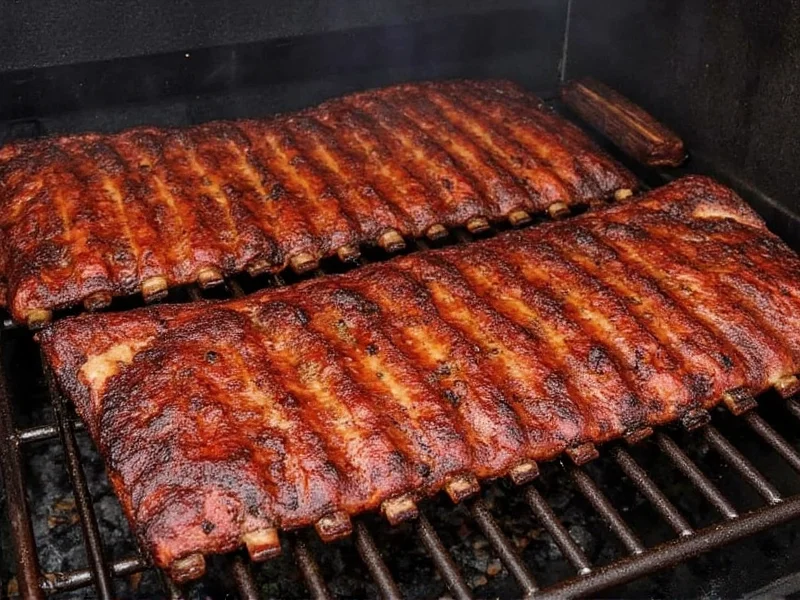Smoking ribs to perfection requires precise temperature control, not just cooking time. Many backyard grillers make the mistake of pulling ribs too early or overcooking them past the ideal window. Understanding the science behind meat temperature transforms your barbecue from hit-or-miss to consistently exceptional.
The Science Behind Rib Doneness
Ribs contain abundant collagen, the connective tissue that makes them tough when raw. As ribs smoke, this collagen converts to gelatin through a process called hydrolysis. This transformation begins around 160°F (71°C) but reaches optimal tenderness between 195°F and 205°F (90°C-96°C).
Below 190°F, ribs remain chewy with incomplete collagen breakdown. Exceeding 205°F risks drying out the meat as excessive moisture evaporates. The sweet spot delivers that coveted "tug" where meat separates cleanly from the bone with gentle pressure.
Temperature Variations by Rib Style
Different rib cuts require slight temperature adjustments due to varying fat content and bone structure:
| Rib Type | Ideal Temperature Range | Texture Characteristics |
|---|---|---|
| Baby Back Ribs | 195°F-203°F (90°C-95°C) | Firm yet tender, maintains shape well |
| St. Louis Cut | 198°F-205°F (92°C-96°C) | Richer flavor, slightly more tender |
| Spare Ribs | 200°F-205°F (93°C-96°C) | Most tender, higher fat content |
Proper Temperature Measurement Technique
Accurate readings require proper thermometer placement:
- Insert probe horizontally between bones, avoiding contact with bone
- Measure in the thickest part of the meat, away from the surface
- Check multiple spots as temperature varies across the rack
- Use an instant-read thermometer for final verification
Many pitmasters make the critical error of checking temperature near the bone, which reads higher than the actual meat temperature. Always measure in the meat itself for accuracy when determining when are ribs done smoking.
Complementary Doneness Indicators
While temperature provides the most reliable measurement, these secondary indicators confirm perfect doneness:
The Bend Test
Holding ribs with tongs at both ends, they should bend significantly with surface cracking appearing at 180°F+. At ideal 195-205°F range, they'll develop a deep 45-degree bend with visible cracks.
Meat Retraction
As ribs cook, the meat visibly pulls back from the bones. At proper smoked ribs temperature, you'll see 1¼ to 1½ inches of exposed bone.
Probe Test
A thermometer or skewer should slide into the meat with little resistance, similar to warm butter. If it meets significant resistance, continue cooking.
Avoiding Common Temperature Mistakes
Several misconceptions lead to subpar results:
- The 180°F Myth: Many outdated guides recommend 180°F, but this leaves ribs chewy with incomplete collagen conversion
- Time-Based Cooking: "Smoke for 5 hours" ignores variables like meat thickness and ambient temperature
- Overreliance on Bark: A perfect crust doesn't guarantee internal tenderness
- Neglecting Resting: Skipping the 20-30 minute rest prevents juices from redistributing
Temperature Troubleshooting Guide
Encountering issues with your smoked pork ribs temperature? Try these solutions:
Ribs Stalling Below 190°F
The stall occurs when evaporative cooling balances heat input, typically between 150-170°F. To power through:
- Wrap in butcher paper or foil after 3-4 hours
- Increase smoker temperature slightly (250°F to 275°F)
- Ensure consistent fire management
Ribs Drying Out Before Reaching Target
If ribs lose moisture before hitting 195°F:
- Lower smoker temperature to 225°F
- Use a water pan in your smoker
- Apply spritzes of apple juice every 45-60 minutes
- Consider wrapping earlier in the process
Resting: The Critical Final Step
After reaching the ideal smoked ribs temperature, resting is non-negotiable. Wrap ribs tightly in foil and then insulated towels for 20-30 minutes. This allows:
- Temperature equalization throughout the meat
- Residual heat to complete collagen conversion
- Juices to redistribute for maximum moisture retention
Slicing too soon causes precious juices to escape onto your cutting board rather than staying in the meat. Patience during this phase makes the difference between good ribs and extraordinary ribs.
Temperature Safety Considerations
While USDA recommends 145°F for pork safety, this temperature doesn't produce tender ribs. The extended cooking time at lower temperatures (225°F-250°F) eliminates pathogens through time-temperature relationships. Always verify internal temperature reaches at least 195°F for proper texture development, well above safety thresholds.











 浙公网安备
33010002000092号
浙公网安备
33010002000092号 浙B2-20120091-4
浙B2-20120091-4